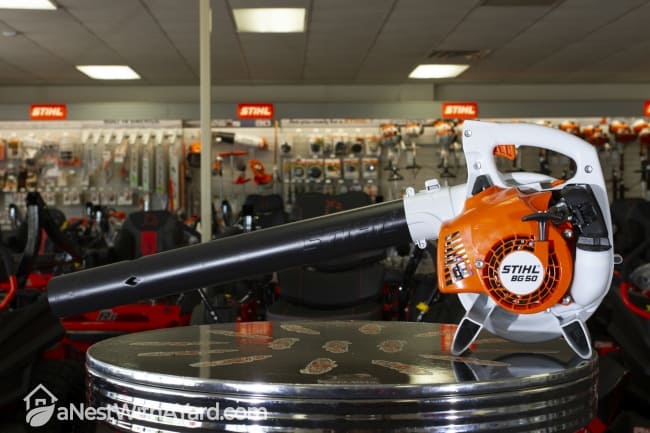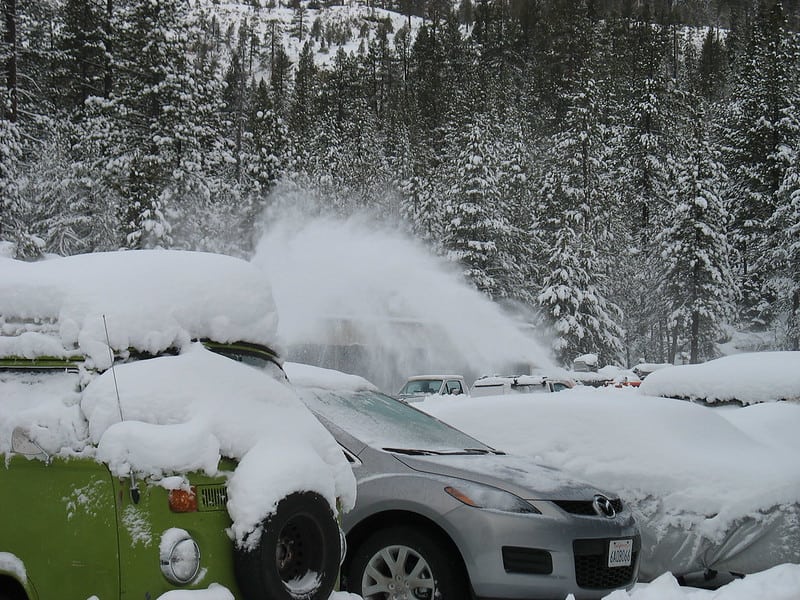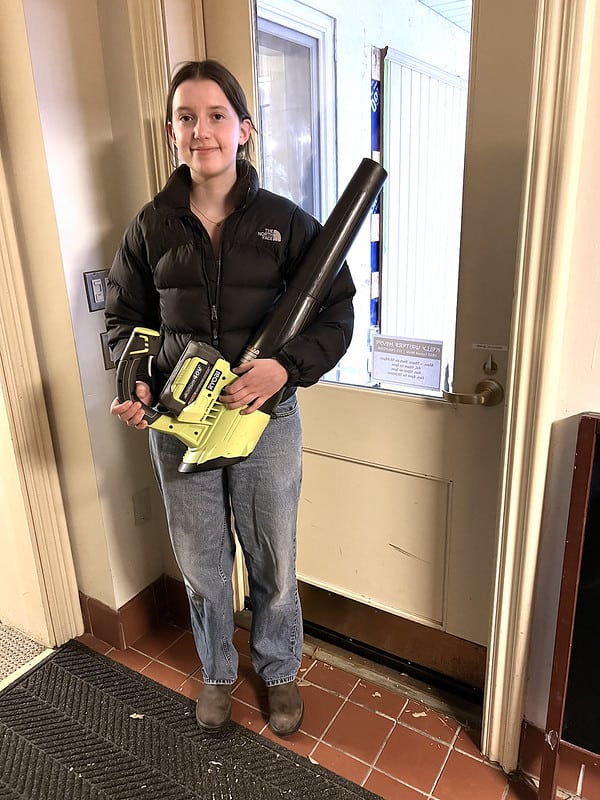You can use a gas leaf blower for clearing fresh snow off your driveway, sidewalk, porch, steps, car, trash cans, and more. Point the leaf blower down at an angle going side to side. Snow removal with a leaf blower is the easiest when the snow is dry, powdery, and no more than 4 inches thick.
Are you tired of shoveling huge piles of snow each winter? Are you on the verge of buying a snow blower from my review list?
Before you do, hear me out! Have you tried using your leaf blower for snow removal?
Your trusty leaf blower can be used for clearing snow off the porch, driveway, car, and much more. There are only a few limitations you need to know before you head outdoors.
So, keep on reading! I’ll explain how you can safely use a leaf blower for snow and settle the leaf vs snow blower debate once and for all.
Contents
- 1 Can You Use A Leaf Blower As A Snow Blower?
- 1.1 Safety Tips For Using The Blower For Snow Removal
- 1.2 How To Clear Away Snow With It
- 1.3 What Kind Of Leaf Blowers Is The Best For Snow Removal?
- 1.4 Removing Snow From Your Car With A Leaf Blower
- 1.5 Can You Use A Cordless Leaf Blower To Clean Snow?
- 1.6 What Kind Of Gas-Powered Leaf Blower To Buy?
- 1.7 Leaf Blowers Vs Snowblowers
- 1.8 What leaf blower is best for snow?
- 1.9 Do I really need a snow blower?
- 2 Retire Your Shovel
- 3 About The Authors
Can You Use A Leaf Blower As A Snow Blower?
Yes, you can use a gas leaf blower to remove fresh snow from your porch and driveway.
An electric leaf blower is not appropriate for this job since water and electricity don’t mix! Even battery-powered leaf blowers!
Use your gas leaf blower to clear away freshly fallen light, dry snow that is no more than 4 inches thick.
Clearing away wet and heavy snow is difficult and not recommended. The engine will quickly overheat, and you will end up breaking it. If you need to clear wet snow, read our post about snowblowers that can do the job well.
I have gathered all the safety tips that you should know in the section below. Let’s take a closer look.
Safety Tips For Using The Blower For Snow Removal

Use a gas-powered leaf blower
Gas-powered leaf blowers are much safer for snow removal than electric units. When using an electric model, you run a risk of getting shocked. Snow can easily enter the engine or dampen the power cord, which is a big no-no.
On top of this, electric units often fail to clear snow quickly and efficiently since they are typically less powerful.
Work in the right weather conditions
Don’t use your leaf blower when it is warmer than 32 degrees Fahrenheit. In these conditions, the snow will start to melt and be too heavy to be blown away.
Don’t use your leaf blower in extremely low temperatures, either. Cold weather can cause serious damage to the engine, especially if it has been stored in an unheated place. Running a cold engine in winter is always a hassle.
You will have trouble starting the leaf blower if you still have a summer blend gasoline in your fuel tank. Once started, the engine will run rough. So, don’t forget to switch to winter-grade fuel at the beginning of the season.
Protect your hearing
If you’ve used a leaf blower before, you know how loud they can be. Clearing the snow from your porch, stairs, and trash cans may take you longer than expected. So, don’t hesitate to use hearing protection.
Earmuffs will protect you from the gradual hearing loss that can occur from years of working with moderately loud tools and equipment.
Proper storage after use
After you’ve cleared the snow, it is only right to properly store your equipment.
Take the leaf blower indoors to let it dry completely. If you leave it in a cold spot before it dries, those wet spots will freeze and cause certain parts to crack or loosen. Let’s not forget that a leaf blower that is kept in a warm place is also easier to start.
How To Clear Away Snow With It
Clearing away snow with a leaf blower requires the proper technique. Blowing snow in every direction possible will leave you with a bigger mess than you started with. You’ll spend hours in the freezing cold, wishing you had just stuck to the shovel.
Keep the leaf blower pointed down at an angle, moving side to side. Be patient, and don’t be too aggressive.
Don’t spend too much time clearing the chunks of wet snow that are stuck to the concrete. Move on with the process. You can always come back with the shovel and make the finishing touches. Check it out:
Use the same technique when removing snow from your car. Start at one side and move on from there. Make sure you clear every bit before going on the road. A pile of snow left on the rooftop can be extremely dangerous at a high speed. Take a look:
Don’t wait for the snow to stop falling to get to work. Clearing the snowfall gradually over the day is much easier than all at once. The longer you let the snow sit, the harder it will be to remove.
What Kind Of Leaf Blowers Is The Best For Snow Removal?
I’ve already established that a gasoline leaf blower is a way to go. Some people still use electric handheld cordless units for light jobs, despite the risks.
The best leaf blowers for snow removal are those that are powerful. If your leaf blower can barely clear away leaves, you should avoid using it on snow.
You don’t have to buy a commercial-grade unit for home purposes. What you need is a model with high airflow CFM (cubic feet per meter) and airspeed MPH (miles per hour). A good CFM for a gas blower ranges from 400-700 and MPH from 145-250.
Backpack leaf blowers are ideal for areas that get tons of snowfall. I especially like the Husqvarna 350BT and 360BT models. Both can remove wet snow better since they have high airflow and can cover larger areas.
Here is how a backpack leaf blower performs on 4 inches of dry snow:
Removing Snow From Your Car With A Leaf Blower

According to Shaun Mendonsa from Master Influencer Magazine, a leaf blower is an excellent choice for cleaning the dry snow off your car, as well as one of the easiest and fastest, especially when cleaning the roof, which is difficult to reach with your snow scraper or brush. The photo above is courtesy of Rennett Stowe.
Check out this video, and you’ll see:
I tried using my leaf blower on my car last winter, and I can vouch that it was super-easy to blow away powder snow. It took me less than 5 minutes! Unfortunately, I could not remove frozen snow that easily. So, use a leaf blower only for powdery, light snow. For wet, heavy snow, try other methods.
Can You Use A Cordless Leaf Blower To Clean Snow?
I prefer using a cordless leaf blower for snow than a corded one. Why? Well, it is common knowledge that electricity and water spell danger. Why risk it when you can purchase a powerful leaf blower that runs on batteries or gas? The video below proves it:
If you still want to use your corded leaf blower for snow, take the advice from Dale V., a leaf blower expert from Leaf Blowers Direct company, and minimize the risk of electrocution by:
- plugging your blower into a GCFI (ground fault circuit interrupter) outlet
- using a GCFI-compatible plug
It’s better to be safe than sorry!
What Kind Of Gas-Powered Leaf Blower To Buy?
When I was looking into buying a gas-powered leaf blower, I realized there are many things to consider. So, I reached out to Dale V. from Leaf Blowers Direct Company again. Here is what he says you should consider when searching for a gas-powered blower:
Air Flow
Two ratings describe the airflow coming out of a gas leaf blower’s tube:
- MPH – miles per hour (measures the speed of the air coming out of the tube)
- CFM – cubic feet per minute, or (measures the amount of air flowing through the tube per minute)
According to experts from the reputable Stihl Company, it is best to find a manufacturer that uses the new measurement method introduced to an existing standard by the American National Standard Institute (ANSI B175.2.). The Newton force rating method combines the MPH and the CFM ratings (air velocity and air volume) into one easy-to-understand measurement. The higher its value, the more work you’ll finish in less time!
Engine Type
Handheld gas leaf blowers can have:
- 2-cycle engines
- 4-cycle engines
I recommend the 2-cycle engine because it is lighter and easier to maintain. The experts from Castrol Limited agree that 2-stroke engines are better for handheld equipment due to their high power-to-weight ratio.
Versatility & Functionality
I recommend opting for a handheld gas leaf blower that doubles as a leaf vacuum. It might not matter much when clearing snow, but a vacuum is a must when cleaning up leaves in the fall. It can shred the leaves, allowing you to fit up to 16 bags of leaves into a single sack.
Leaf Blowers Vs Snowblowers
A snowblower and a leaf blower can both help you clear the snow from your driveway, each in its own way. But which tool is better for the job? Let’s find out:
Snow Blower: Pros And Cons
A snowblower is a tool specifically designed for snow removal. Its auger breaks up and loosens compacted snow, pulls it in, and discharges it to the side. It can clear high amounts of wet or dry snow.
Snowblowers can be powered by electricity or gas. You have the option to choose an electric cordless unit from my list if you don’t like dealing with having to buy gasoline or annoying electrical cords.
Pros:
- Can easily remove hard-packed snow, unlike leaf blowers.
- Clears snow much more quickly and more efficiently.
- Typically more powerful than leaf blowers.
- All units are optimized for winter conditions.
Cons:
- Can only be used during winter for snow removal.
- Are bigger and require more storage space.
- Typically require more maintenance than leaf blowers.
- Use up energy pretty quickly.
Leaf Blower: Pros And Cons
A leaf blower ejects pressured air powerful enough to move leaves, small twigs, dirt, and other bits and pieces from your lawn. They are primarily used in the fall, but you can extend its usage through the winter and use it on light, fluffy snow, as well.
Pros:
- Can be used throughout all seasons of the year.
- Removes snow from nooks and crannies where the snowblower fails to reach.
- Not limited to ground use.
- Easier to carry and operate than a snow blower.
- Smaller and lighter, which makes for easier storage.
Cons:
- Limited strength and efficiency.
- Can’t clear heavy snowfall like a snow blower can.
- Cold can affect its performance.
- Electric units not optimized for winter conditions.
What leaf blower is best for snow?
A gas-powered leaf blower is best for snow removal. It is safer for clearing snow than an electric leaf blower.
Do I really need a snow blower?
You do not need a snow blower if you already own a powerful leaf blower and live in a region that doesn’t get a lot of snow. Leaf blowers can clear snow up to 4 inches high.
Retire Your Shovel

Can you use a leaf blower for snow removal? Yes! Feel free to retire your snow shovel! The photo above is courtesy of kellywritershouse.
A leaf blower will serve you well in the fall, as well as the winter. Just make sure you are using a gas-powered model on snow.
Follow the safety precautions I have listed above, and you will have a clean driveway in a matter of minutes. No more back pain and freezing in the cold for hours.
However, keep in mind that this solution might not be suitable if you need a lightweight machine that’s easy to operate. If you are looking for such a model, read this post and this one.
Have you used a leaf blower on snow before? How did it go? Let me know in the comment section below, and feel free to ask any questions on the topic, as well.






I have a Craftsman battery powered leaf blower. Is it good with snow or is it a waste of my time. I have ramps for my dog who has motor issues so I need it as safe as possible.